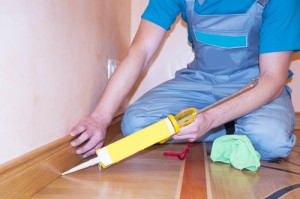Silicone caulk can be put to a variety of uses in your home. It’s never a bad idea to have some spare caulk lying around in order to tackle any necessary repairs. Here are five areas where you can put silicone caulk to good use.
Walls
Caulk is perfect for quick fixes to small areas of your interior and exterior walls. Use it to fill gaps in bricks or cement, repair cracks, or fix small holes left by nails and screws. Caulk is ideal for these projects because it is both a cheap material, and won’t shrink or crack while forming to the area.
Attic
Lots of heat is allowed to escape through your attic in the winter. You can minimize that energy loss with properly fitting insulation, but you also need to use caulk to seal up any remaining gaps. This provides protection against energy loss, and also prevents insects from getting into your home from the attic.
Floor
Another place where energy is often lost is in the floor. This process will change based on the type of flooring you’re working with. For bare wood floors, you’ll want to try to match the color of the caulk with the wood because caulk won’t take stain or paint. You’ll want to inspect for any gaps between floorboards as well as gaps between the floorboards and the floor. For concrete floors, you won’t need to concern yourself with the color of the caulk if it will be covered by concrete or tile.
Windows
Your windows can also be a great place to save on energy costs, but again, caulk is needed to finish the job. After replacing your windows, seal up the edges with silicone caulk. You may not visibly be able to see any obvious gaps, but without this additional seal, air may still be able to get in. Even if you’re not installing new windows, caulking old windows could result in significant savings on your energy bill.
Water Seal
Finally, anywhere there’s water that you need to keep in or out, silicone caulk is usually the best material for the job. Around bathtubs and sinks, caulk creates a water tight seal that keeps water in the vessel, and not causing water damage when leaking out. For showers, caulking around the shower cubicles is only the start. You’ll also need to caulk around shower tiles to prevent water from affecting the grout or drywall.
For silicone caulk, caulking guns, and additional water proofing and sealant materials, come see us at Maxwell Supply in Tulsa.
